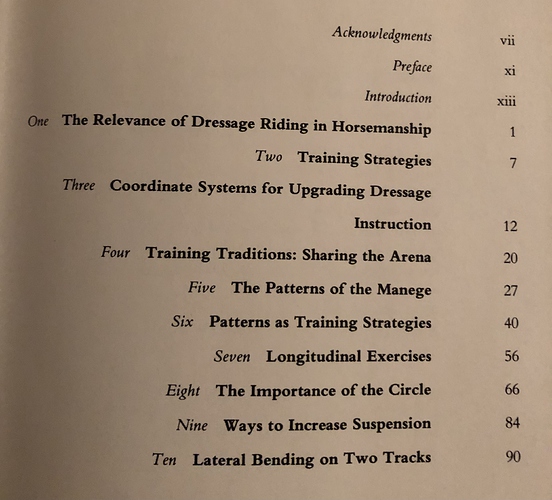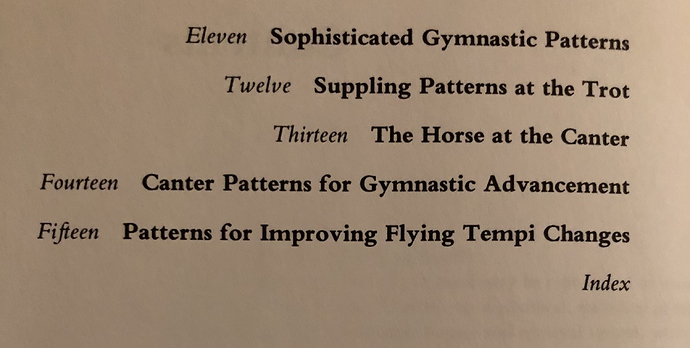I know there are lots of books of exercises out there. Are any of them organized in such a way that you can find an exercise to address, say, improving the shoulder in or the half pass? (I know it’s all basics. Just looking forward a resource to give me more ideas that I have in my lists! ) Tia.
Maybe Charles de Kunffy’s Athletic Development of the Dressage Horse? Some of the chapters address specific issues, although the issues might be more general than you’re looking for. Here are pics of the TOC in case that helps.
Thanks. Certainly his work is classic. Ill look for it.
I ditto the Athletic Development.
Perhaps too, it is not the exercise that needs improvement but the rider’s ability to correctly perform the movement. That takes a dressage instructor’s eye
.
I think a great coach is priceless. No one exercise can fix “shoulder in” or “half pass” as there can be so many issues with each. Is there a lack of bend, dropping shoulder, swinging front end or hind end, not through, not carrying… Without understanding what problem you are dealing with and the preparatory steps to address the weakness/fault it will be more bad practice. Is it the rider causing issues? Is the horse just not prepared to do what the rider wants? Is the rider not feeling/understanding what he/she is asking or getting from the horse?
We all wish to be Olympians, but even those elite athletes get input from a coach not only books
Books are good for laying out a scheme, but learning/having feel is a gift or a hard won battle with lots of supervised hours of training and targeted practice…
Janet Foy’s “Dressage for the Not So Perfect Horse” has a chapter for each family of movements. Each chapter lists the USDF directives for the movement, provides a numerical list of possible evasions by the horse, and suggests exercises to correct each evasion.
Of course eyes on the ground are invaluable. I have a good coach/trainer who has brought me up into FEI from a shaky 3rd level in just a few years.
That said, everyone I know has told me that since I have brought Bravo home, and am riding more often on my own rather than under the constant eye of a trainer, my feel for what is going on (that dropped shoulder etc), my position and, well, my riding as a whole has improved.
While I lesson and clinic (with a select few clinicians) often, sometimes I just want to work on something - like lateral work. It would be nice to have a selection of exercises at hand - some other than the ones my trainer/clinicians use, just to see something different. I have tried to plan my rides this year (with limited success) and I am determined to be better at that aspect of being a rider in 2021. A journal helped last year, then COVID… and I slipped away from the discipline of it.
I will look for Janet’s book. I did not catch her presentation at the USDF Convention but plan on watching it as soon as those educational sessions are posted by USDF.
And I have to wonder how a search for a book of exercises somehow devolved into a lecture on needing a trainer / eyes on the ground (thank you, I have a great one as well as two clinicians I work with), and a lecture on how it is often the rider causing the issue. As if every dressage rider did not know this. I certainly do, and I certainly recognize that I have a weaker and a stronger side.
Typical Chronicle I suppose.
Merry Christmas all.
@lorilu I have no suggestions for you but I think it’s a great question! I also ride often alone (although I too take lessons/ride in clinics.) Sometimes I need some inspiration and guidance. Plus I love to read. I also love taking lessons but I can’t lesson multiple times a week- I wish!
I for one appreciated your question.
I do not ride in black tack but I am always looking for ways to expand my toolbox. Schooling a more diverse selection of exercises can help us and our horses to have a lightbulb moment in carrying the body, not only to contribute to movement X but to develop the horse’s overall flexibility, suppleness, and physical well-being. I’m getting some new reading material from this thread also.
I too appreciate your question and have been following this thread for many of the very reasons you sight. I’ve been having a particular problem with one issue. I know what the basic elements are that I need to correct/improve but having exercises that allow me to chip away at the ‘brick wall’ in a fun and interesting way so that I can get there without frustrating or boring my horse would be helpful. My instructor does give me homework in the form of exercises to employ while riding on my own at home which I find invaluable but sometimes I must go a few weeks without a lesson. Having additional tools in my tool box is always on my mind and not only gives me the ability to use variety in my riding they also test me in terms of feel and blind faith. It’s all too easy to ‘work’ on an exercise at home without an instructor or guiding eye and ‘think’ you’ve got it only to find out one week later when taking the next lesson that you don’t. By utilizing additional exercises that may serve a similar purpose I can often ‘test’ or catch myself before I get lulled into drilling that imperfect practice trap. At least that’s what I strive to avoid and/or achieve.
@lorilou
That is because 'Correct exercises " produce correct results, but we all need help making sure those exercises, which appear so simple to execute, are indeed being executed correctly.
A simple 20m circle is not too simple or correct if the inside hind is not stepping under every step of the way. And that circle is a foundation exercise.
But I am sure you will agree that 1. Not every horse needs the same exercise for the same problem and 2. Having more tools in your box is important ( thanks @exvet).
Add me to the list of people who appreciate the question!
I go at least 2 weeks between lessons and at this time of year I spend more time driving than riding, so my ridden arc of progress/improvement is considerably different. But I still have an idea of what areas need work/improvement in those 2 ridden days out of 7 - for both ridden dressage (less emphasis) and driven dressage (huge emphasis). It. would be super useful to have more ideas on targeted exercises, and on that note I did get de Kunffy’s book and stuck Foy’s book on a list to buy after I finish the first.
I know this isn’t a “pure dressage” book, and I haven’t read it yet, but based on its description I wonder if the Jane Savoie book “Dressage Between the Fences” would be of any interest? It sounds like it recommends exercises to target specific issues, although not specific movements (except for flying changes).
Description from Amazon:
Renowned author and mental training coach Jane Savoie breaks down the six most common problem areas she sees when horses jump:
- “Whoa” and “go”
- Rhythm
- Suppleness through the poll, neck, body, back, and hindquarters
- Contact and connection
- Collection
- Flying changes
Then Savoie fills the rider’s toolbox with targeted exercises on the flat―simple solutions to the nagging problems that prevent riders and horses from doing their best over all kinds of obstacles, whether competing in hunters, jumpers, equitation, or eventing.
I’m thinking of buying it and if I do I’ll try to remember to report back.
You might try “The Complete Guide to Dressage” by Jennie Loriston Clarke.
It’s an older book but I think you can still get it from Amazon.
Breaks down all the movements ,has some exercises and has some great photographs that contrasts incorrect movements with correct movements.
She also has some other works on dressage.
I like this book because she uses photographs instead of drawings to illustrate her points.
There are not a lot of exercises but she does describe in great detail what the exercise is meant to address.
In fact I jsut bought this one from a friend who was downsizing!
Check out Miguel Tavora’s book. Lots of different and interesting exercises for everything from shoulder in, flying changes to Piaffe. I just read it recently. I was impressed.


